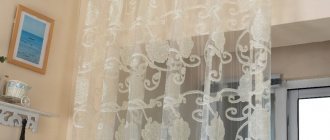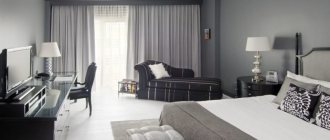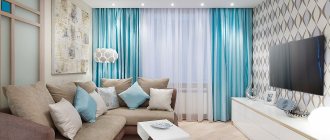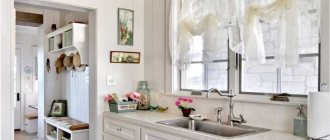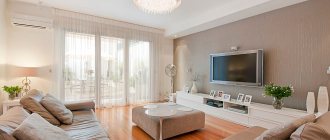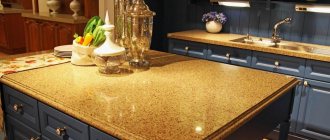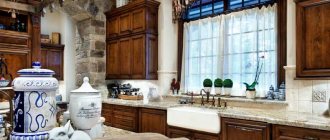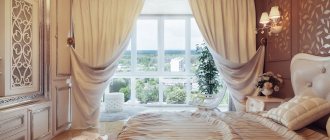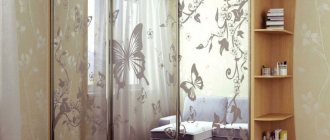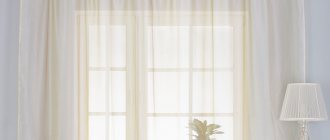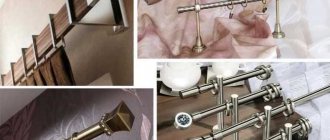Help the site, share with friends:
Agree, no human home is created as carefully as a bedroom. This is not only a sleeping area, but also a space for relaxation.
Bedroom design is developed very carefully and tulle for windows plays a huge role in this matter.
Why do you need tulle in the bedroom?
Tulle in the bedroom gives the room coziness and warmth. Plus it makes the room look complete.
If the window in the bedroom faces the street, where it is crowded, then thick tulle will help hide from prying eyes, and thin tulle will visually enlarge the room and muffle direct sunlight.
Style matters
Modern designers recommend choosing different curtain designs to personalize your bedroom.
Here, for example, is the “classic” version, or as it is also called traditional. Its basis is thick, heavy curtains hanging along the edges of the windows, and the entire center is filled with weightless tulle. During the daytime, the bedroom curtains elegantly outline the window, and at night they close off the outside world. This option is very popular among the average person.
The option of “Roman blinds” cannot be ignored. It's like a blind. A dense, smooth canvas covers the window up to the windowsill. Adjustment is carried out using a special cord attached to the slats on the inside of the curtain, by pulling or releasing.
The French curtain option is most often found in a theater or concert hall. Light, airy fabrics are ideal for it. They can be chosen to create an interior in the living room. However, if you decorate with a high-quality and original lambrequin or use tulle, the bedroom will take on the appearance of a palace chamber.
Recommendations for choosing tulle
How beautiful is this tulle for the bedroom? The most correct decision to choose curtains is at the stage when the design of the room itself is being developed.
If you are decorating the bedroom interior yourself, then first it is better to study the assortment in the markets, the variety of shades and the price of the material.
Where to begin? Let's start with the footage. How much tulle do you need for a bedroom? First, measure the length of the cornice.
If the width of the fabric is 2 times the length of the cornice, then you can get an interesting drapery.
But this depends on the type of tulle; when it is thin, the width is 3 times larger, and for curtains with embroidery it is better to reduce the number of folds.
How to choose the right fabric? There are several types of fabric from which tulle is made.
Take measurements
Before you sew yourself or order curtains from a specialist, carefully take measurements from the window with a measuring tape. Ideally, measurements are taken after installing the cornice.
Related article: Curtains for the kitchen of different sizes (+42 photos)
In the case of installing a wall curtain rod, wider curtains, there will be a distance between the extreme fasteners. At the same time, make an allowance for the fold of tens of centimeters. The allowance depends on the chosen curtain model.
To sew tulle, you need to take two or even three window widths, it all depends on the fabric. Length is the distance from the eaves to the floor.
When mounting cornices on the ceiling, measurements are taken similarly to the option described above. The only difference will be that the length is measured from the ceiling.
Organza
Recently, this fabric has proven itself not only as an interior decoration, but is also often used for bouquet arrangements and for clothing decoration.
The material has become popular due to its dense structure, but the fabric itself, in turn, is transparent and weightless.
Organza is made from polyester and viscose; the material determines how expensive the tulle will be.
The design of tulle for the bedroom is made with embroidery elements, and sometimes perforations are made with rhinestones. To dress up a room, you should choose organza for tulle with golden pollination.
Long
Translucent floor-length curtains are presented as one continuous sheet or consist of two halves. However, windows are often decorated with a large number of curtains - for example, three or four narrow canvases.
This fashionable technique is very practical, because it provides easy access to the window that you probably open sometimes. And curtains of different shades will also help create a single color ensemble, for example, as in these photos.
The shape of the curtains resembles a rectangle, square, semicircle and triangle. Two or three of these types make very original combinations. Asymmetrical tulle is now especially relevant and convenient for decorating rooms with a balcony door.
Important: when choosing curtains, keep in mind that complex voluminous patterns on curtains do not look best in rooms with a large number of objects and decor.
Tulle can be plain, with patterns, ornaments, three-dimensional patterns or photo printing. The color of the curtains usually harmonizes with the walls, floor, bedspread, pillows, upholstery, lampshades and other interior items. With such a huge selection of curtains, you can easily choose a plain tulle that matches your interior.
But there are two more ways to create color harmony - curtains with an ornament (pattern) and accessories, a section about which awaits you ahead. Patterns are often located only at the bottom of the tulle, which can be wavy, angular, fringed, frilled, etc.
If we talk about curtains with photo printing, many designers claim that they will remain a thing of the past. But why not admire a forest landscape or a waterfall, especially if the rest of the furnishings are not full of different colors. Another achievement of civilization - luminous curtains - an excellent window decoration on the eve of the holidays.
The image on curtains is often duplicated on other home textiles in the same, as well as enlarged or reduced form. Small splashes of color and raised patterns on a translucent background can simply match the overall tone or individual bedroom items, as in these photos.
However, if you want, complement the tulle with candles, cute night lights, and other little things - the main thing is that you like it.
If you are interested in current colors, we are ready to share the information we have collected on this matter.
Veil
It is a thin, lightweight weave fabric. The material got its name from the nets that women used for hats and covered their faces with them.
The veil is produced in different colors, sometimes with a printed pattern. The fabric is soft, which allows the specialist to create any folds.
Why is Netflix so popular?Orthopedic mattresses with independent springs, what is special about them
- Posters and reproductions in the interior
It is transparent and allows daylight to pass through, and canopies are often made using this material.
Lambrequins
In a short time, these decorative elements have already managed not only to return to fashion, but to become its latest squeak. In addition, lambrequins continue to be replenished with new varieties. Soft models, characterized by pleasant folds, will, if necessary, complement the color scheme of the room and give it romance or solemnity - as you wish.
Swags, fringes, molds and jabots - all these lovely details with elegant folds once adorned royal canopies. Today they fit perfectly into classic interiors.
Modernized ones also appeared - rigid lambrequins, characteristic of a more ascetic environment. They are a rectangular or figured strip of material covering the cornice.
But the most unique variety is openwork tulle. It looks, of course, stunning, and is combined, like other types, with all types of tulle. However, judge for yourself by looking at the photo.
Viscose
Beautiful tulle for the bedroom is made from this material. Today, a very popular synthetic fabric that is not durable.
It may be made in one shade or with embroidered patterns and ornaments.
History of creation
According to history, this wonderful fabric appeared 6 centuries ago in France, in the city of Tulle. At the request of the king's own bride, the weavers created a fabric through which only the lady's silhouette could be seen and nothing else.
The weavers of the city of Tulle carried out the bride’s order, and she, in turn, was very pleased with the result. Subsequently, a wedding dress was made for the bride from this material. And the fabric began to be called after the name of the city - tulle.
"Tulle" is a masculine French word. As a result, it is worth saying: “tulle is he.”
Characteristics of choosing tulle color shades
- If dark tulle or a voluminous pattern is chosen for the bedroom, then there will be very little street light in the room.
- Tulle in dark shades visually reduces the space and brings the window opening closer. It is better not to use a curtain in this color scheme if the bedroom is not large.
- The color of the tulle must be combined with the shade of the curtains and the overall design of the bedroom.
- Typically, tulles of soft and light shades are selected for bedrooms because too bright colors have a bad effect on the mental state.
- White tulle in the bedroom can quickly turn yellow, while colored tulle can fade.
- The best option would be curtains whose material is yellow and green.
Types of material
At the very beginning of the production of tulle fabric, it was made from linen, silk or cotton. The material looked impressive, but costs a lot of money. With the development of technology, the manual component of weavers' labor was replaced by a machine one, which significantly reduced the cost of finished products. The spread of synthetics has not spared tulle - now this material has a huge variety of colors and patterns, but anyone can afford it. Tulle is made from polyamide, and embroidery is applied with it - the material is smooth and soft. It is worth paying attention to several main types of tulle.
Organza
A fabric with a slight oriental feel, made from silk, viscose or polyester. The material is quite hard to the touch, but has a good level of strength. There are two subtypes of organza:
- shiny;
- matte.
The material is changeable - at certain angles it can change its color. If the fabric is processed under a special press, the effect of wrinkles is obtained, which looks very impressive in modern interiors. For luxurious classics, coated organza is suitable, looking very solemn and elegant. This material is chosen for the bedroom because of its performance characteristics - the fabric does not wrinkle, does not shrink and does not require complex care methods. The finished canvas is so light and airy that it is actively used to decorate rooms in romantic styles.
Organza is decorated with various patterns - the more complex the application method, the higher the cost. The most luxurious material is silk organza with hand embroidery. Most often you can find patterns on a floral theme, but the variety of patterns is not limited to this. The color palette is huge, so you can choose curtains according to your desires. Can be used as independent curtains or in combination with thick curtains.
Veil
This type of fabric has a fine mesh structure, somewhat reminiscent of dense gauze. The veil is an elite material - it is usually made from natural cotton. The fabric is very pleasant and soft to the touch, has a delicate texture. Suitable for conservative and modern interiors, as it has a smooth matte surface. Sometimes designs are applied to the fabric by mechanical processing or hand embroidery. There are several important points to pay attention to.
- The fabric is difficult to care for, but in return it creates an amazing feeling of lightness and airiness in the room.
- The material is suitable for multi-layer drapery - thanks to its soft texture, flowing folds are obtained.
- Voile is a luxury fabric, so you should prepare for serious expenses.
The color scheme of the material is distinguished by delicate pastel tones, but a variety of effects are actively used when one color smoothly transitions into another. The “Carnival” veil model is widespread, when the bottom of a heavenly shade flows into the top of a snow-white color. In combination with smooth folds, the effect of sea waves is obtained, relevant for bedrooms in the Art Nouveau style. Dark shades of veils have also gained popularity - shades of bronze, ash and chocolate are in fashion.
Kiseya
Kissey fabric consists of many decorative threads. Such curtains do not protect from sunlight, but this is not their main purpose - thread curtains are used as an effective element of decor and zoning of space. The panel is classified as an original curtain; it will fit perfectly into modern and oriental interior designs. Synthetic threads are used to make muslin curtains, as they do not fade in the sun and are characterized by increased strength. This is important for those muslin models where the threads are less than 2 millimeters thick. Thread curtains from 3 to 10 millimeters thick are also made from natural materials, but such panels can wrinkle.
Classic curtain design
This style differs from others in its restraint, correctness, and elegance. The presence of patterns in the shape of flowers is specific to him. The most popular are radiant colors: beige, white, light pink, etc.
Combinations of several colors are possible.
